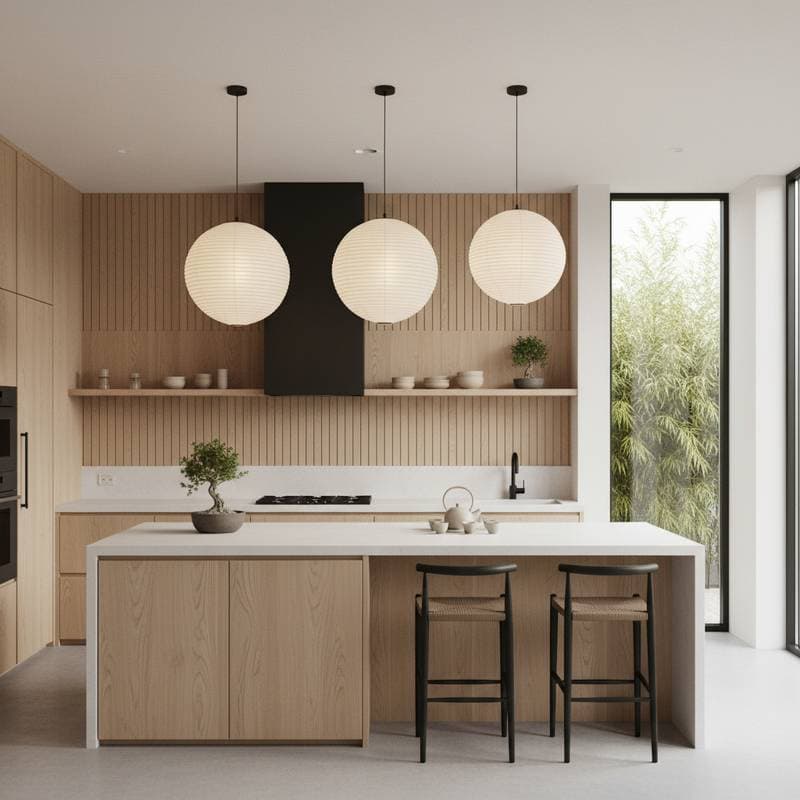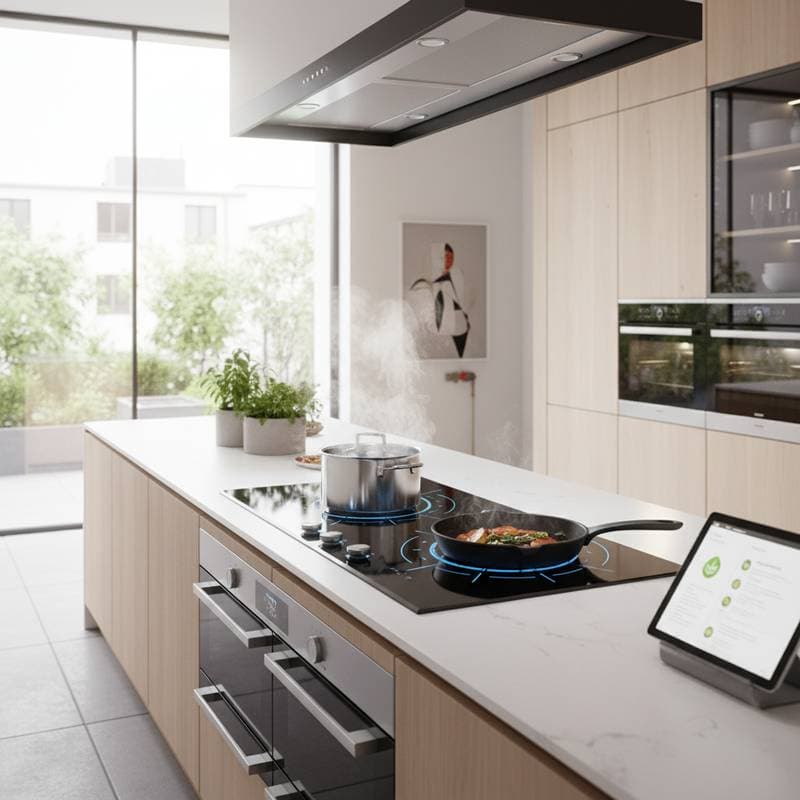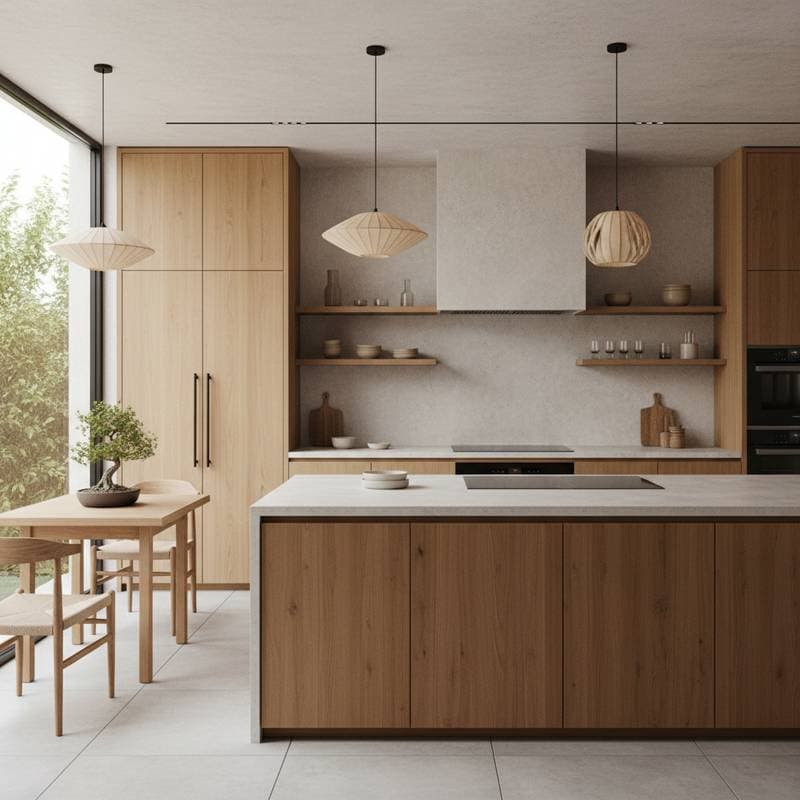Japandi Kitchens: Minimalist Warmth Redefined for 2025
Homeowners often examine their kitchens and sense an imbalance. The area functions adequately, yet it appears cluttered one moment and chilly the next. Individuals seek a space that maintains cleanliness while radiating invitation. This equilibrium proves challenging, though one design approach achieves it with grace: the Japandi kitchen. This style fuses Japanese minimalism and Scandinavian warmth to produce serene, efficient, and comfortable environments.
Addressing Common Kitchen Challenges
Numerous residents face difficulties in merging streamlined aesthetics with genuine coziness. Contemporary kitchens sometimes evoke sterility, whereas traditional rustic elements can seem burdensome or outdated. Japandi design resolves this divide by prioritizing simplicity, skilled workmanship, and organic substances. The result yields a kitchen that embodies both restraint and hospitality.
For those contemplating a renovation or minor overhaul, Japandi provides a clear path to an enduring, stress-free setting. The following sections outline practical methods to integrate this aesthetic into any home.
Foundations of Japandi Design
Japandi draws from two traditions that champion tranquility and intentionality. Japanese principles stress harmony, precise lines, and reverence for the natural world. Scandinavian elements introduce coziness via pale timber hues, gentle fabrics, and practical arrangements. Combined, these influences fashion a kitchen that encourages mindful engagement with daily routines.
Essential components encompass exposed shelving, non-reflective surfaces, and a subdued spectrum of colors. Each object serves a distinct role, with excess banished to preserve order. Nevertheless, the environment retains an approachable quality, far from starkness.
Guide to Building a Japandi Kitchen
-
Establish a Neutral Foundation
Select gentle, subdued shades such as creamy white, earthy clay, or soft taupe. These hues form a soothing canvas that accentuates organic elements. Steer clear of shiny coatings; opt for matte or satin applications on walls and cabinets to achieve a velvety, inviting surface. Test samples in natural light to confirm they harmonize with your existing setup. -
Incorporate Abundant Natural Materials
Timber forms the cornerstone of this aesthetic. Light varieties like oak, birch, or ash evoke Scandinavian roots, while deeper tones such as walnut or bamboo nod to Japanese heritage. Balance them strategically, for instance, by matching pale oak cabinets with a rich walnut island top. Extend this approach to flooring with wide-plank engineered wood or bamboo tiles for durability and warmth underfoot. -
Streamline the Layout for Efficiency
Prioritize usability above all. Maintain unobstructed countertops and concealed storage solutions. Employ slab-style cabinets with seamless pulls and introduce open shelving for everyday essentials. During a remodel, evaluate the removal of overhead cabinets along one wall to enhance spatial openness and airflow. -
Build Warmth Through Layered Textures
Introduce comfort via fabrics and understated accents. Install linen drapes at windows, select rattan-seated barstools, and display handmade ceramic serveware. Restraint defines minimalism, yet intentional selections infuse depth. Consider adding a woven runner on the floor to soften hard surfaces without overwhelming the palette. -
Choose Organic Lighting Solutions
Lighting should mimic natural diffusion. Install pendants featuring rice paper, woven rattan, or etched glass to cast a gentle glow. Integrate slim LED strips beneath cabinets for task illumination that remains discreet. Eschew intense downlights or elaborate chandeliers; focus on fixtures that complement the room's serene vibe. -
Integrate Thoughtful Greenery
Introduce vitality with minimal foliage. Position a lone fiddle-leaf fig in a stone pot or arrange a few eucalyptus stems in a simple vase. Low-maintenance options like ZZ plants, peace lilies, or compact succulents thrive in kitchen conditions. Place them near windows to draw in light and purify the air subtly.
Key Practical Aspects
Budget Estimates:
Japandi adaptations suit diverse financial plans.
- Basic DIY Adjustments: Repainting cabinets, swapping pulls, and organizing storage typically range from $500 to $2,000.
- Moderate Overhaul: Installing fresh cabinet fronts, surfaces, and resilient flooring often totals $10,000 to $25,000, varying by material quality.
- Luxury Transformation: Bespoke cabinetry, premium fixtures, and artisanal details surpass $40,000.
Project Duration:
Weekend projects for DIY efforts suffice for quick wins. Comprehensive renovations extend over months, particularly with modifications to utilities.
Regulatory and Safety Measures:
Relocating pipes, rewiring outlets, or modifying load-bearing walls demands approval from local authorities. Engage certified experts for any gas or electrical tasks. The apparent simplicity of Japandi requires meticulous preparation to ensure structural integrity and safety.
Enduring Benefits of Japandi
This kitchen style transcends fleeting fashions. Its classic appeal and emphasis on utility position it as a wise long-term choice. Robust choices like solid hardwoods and quarried stone enhance resilience against wear. Upkeep proves simple, given the focus on bare expanses and wipeable coatings.
Sustainable options, including low-energy bulbs and efficient devices, align seamlessly with the ethos. Residents frequently extend these tenets to adjacent areas, fostering overall harmony and diminished daily tension.
Embracing Daily Life in a Japandi Kitchen
As the design materializes, users observe shifts in interaction with the space. Meals preparation gains focus, tidying streamlines, and the atmosphere promotes relaxation. Preserve open counters, refresh accents seasonally, and maximize daylight to sustain vitality. Even incremental steps, such as applying a fresh neutral coat or installing minimalist pulls, yield noticeable enhancements.
Japandi kitchens demonstrate that restraint and solace coexist harmoniously. Deliberate decisions craft an environment that nourishes both visually and emotionally, greeting inhabitants with quiet assurance each day.








